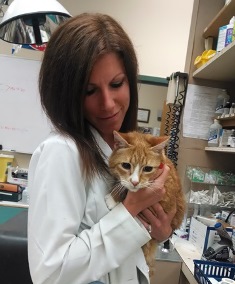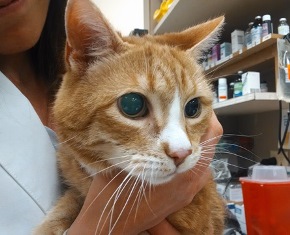Animals can suffer from either high or low blood pressure, just like humans. If left untreated, it can have quite debilitating effects. The signs of high blood pressure (hypertension) can be very subtle and insidious. This is why it is important to have your senior pet’s blood pressure checked on a routine basis.
 It is not uncommon for our pets to have hypertension with no clinical signs at all. In humans, hypertension is often referred to as a “silent killer” because there may be no warning signs or symptoms.
It is not uncommon for our pets to have hypertension with no clinical signs at all. In humans, hypertension is often referred to as a “silent killer” because there may be no warning signs or symptoms.
Humans tend to develop primary hypertension or idiopathic hypertension (no known underlying cause). Often there is a genetic predisposition. Dogs and cats, on the other hand, typically develop secondary hypertension. Their high blood pressure is usually the result of some other underlying cause or disease process.
The most common causes in animals are chronic renal (kidney) disease, hyperthyroidism and hyperadrenocorticism. Therefore, hypertension in our dogs and cats can be an indicator that something else is going on. It should always prompt further testing.
If hypertension is left untreated, it can have many side effects. Hypertension can affect the eyes, kidneys, heart and brain. Typically, the treatment is to first treat the underlying cause (i.e. if there is hyperthyroidism, get the the thyroid disease under control).
Secondly, oral medications can be used to decrease the blood pressure. The following are some of the common sequela to untreated hypertension:
Eyes: The vessels in the retina are extremely sensitive to high blood pressure. It is not uncommon for a pet (usually cats) to present with vision loss secondary to retinal hemorrhage or detachment. They can also present with hyphema (frank blood in the eye).
Kidneys: Although kidney disease is often seen as an underlying cause for hypertension, high blood pressure can actually make kidney disease worse. Kidney disease and hypertension can be a vicious cycle – one exacerbating the other. Approximately 75% of cats older than 7 years will develop kidney disease or hyperthyroidism. Of that group, 75% will go on to develop high blood pressure. So it is imperative to check blood pressures in ANY patient with known kidney disease or thyroid disease.
Heart: Hypertension can also have deleterious effects on the heart. High blood pressure increases the “load” that the heart has to deal with and consequently, the heart has to work much harder than normal. The myocardium (heart muscles) can become enlarged and dilated. The enlarged heart muscles are more sensitive to injury. High blood pressure can also cause abnormal heart rhythms or gallop rhythms, especially in patients with hyperthyroidism. Anytime the heart is significantly affected or compromised, sudden respiratory distress or even death is unfortunately a possible outcome.
Brain: There are many tiny blood vessels in the brain. When an animal has hypertension, blood vessels can become diseased and susceptible to injury. The small fragile blood vessels in the brain are at risk for hemorrhage. And areas of the brain are susceptible to either ischemia (injury due to a shortage of oxygen) or swelling. When this happens, patients can have behavior changes, act dull or depressed, circle, fall over or even seizure.
CASE STUDY:
Celtic, a male neutered 15 year old domestic short haired cat, presented to Belle Mead Animals Hospital for vision trouble. On physical exam, Celtic had extremely dilated pupils and was in fact blind. Torturous and ruptured blood vessels were noted on examination of his retinas.
Celtic had very high blood pressure (hypertension) which was easily documented with a petMAP (small machine specifically for veterinary medicine to get blood pressure measurements). The high blood pressure prompted me to immediately check Celtic’s blood work and urine (including thyroid levels).
Celtic had significant elevations in his kidney enzymes and was diagnosed with chronic kidney disease and secondary hypertension. He was immediately started on an anti-hypertension medication as well as treatment and supportive care for his kidney disease.
(Authored by Heather Simon, VMD)



